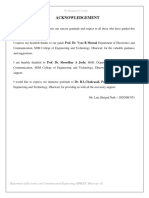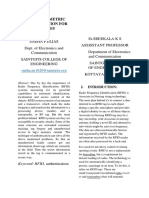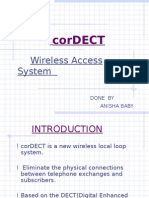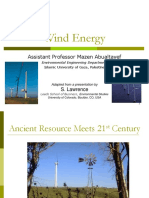0 ratings0% found this document useful (0 votes)
Scsa4002 5GNetworks
Scsa4002 5GNetworks
Uploaded by
madhuretha.tamilselvanCopyright:
© All Rights Reserved
Available Formats
Download as PDF, TXT or read online from Scribd
Download as pdf or txt
Scsa4002 5GNetworks
Scsa4002 5GNetworks
Uploaded by
madhuretha.tamilselvan0 ratings0% found this document useful (0 votes)
Original Title
scsa4002-5GNetworks
Copyright
© © All Rights Reserved
Available Formats
PDF, TXT or read online from Scribd
Share this document
Did you find this document useful?
Is this content inappropriate?
Copyright:
© All Rights Reserved
Available Formats
Download as PDF, TXT or read online from Scribd
Download as pdf or txt
0 ratings0% found this document useful (0 votes)
Scsa4002 5GNetworks
Scsa4002 5GNetworks
Uploaded by
madhuretha.tamilselvanCopyright:
© All Rights Reserved
Available Formats
Download as PDF, TXT or read online from Scribd
Download as pdf or txt
You are on page 1/ 1
SATHYABAMA INSTITUTE OF SCIENCE AND TECHNOLOGY SCHOOL OF MECHANICAL ENGINEERING
L T P Credits Total Marks
SCSA4002 5G NETWORKS
3 0 0 3 100
COURSE OBJECTIVES
To gain in depth knowledge of wireless networks for the future communication systems.
To study the concepts of wireless networks for the future communication systems.
To discuss 5G networks and its applications.
UNIT 1 MULTI-GIGABIT WIRELESS NETWORKS 9 Hrs.
Next generation (5G) wireless technologies- Upper Gigahertz and Terahertz wireless communications: Millimeter wave
networking - Directionality and beam forming- Mobility and signal blockage - IEEE 802.11ad (60 GHz WLAN) MAC and PHY
overview: Visible light communication- High-speed networking using LEDs - IEEE 802.15.7 PHY and MAC overview Sensing
through visible light- Visible light indoor localization and positioning.
UNIT 2 INDOOR LOCALIZATION AND RF SENSING 9 Hrs.
Smartphone localization - WiFi fingerprinting - protocols and challenges - Non-WiFi localization - Device-free sensing with
radio frequency - Mining wireless PHY channel state information- Device- free localization and indoor human tracking -
Activity and gesture recognition through RF.
UNIT 3 LOW-POWER NETWORKING FILTERS 9 Hrs.
Backscatter communication - Radio Frequency Identification (RFID) technology overview - Energy harvesting tags and
applications- Internet-of-Things (IoT) - IoT protocol overview - CoAP and MQTT - IPv6 networking in low-power PANs
(6LoWPAN).
UNIT 4 FUTURE MOBILE NETWORKS 9 Hrs.
Drone networking - Multi-UAV networks, architectures and civilian applications-Communication challenges and protocols for
micro UAVs- Connected and autonomous cars - Wireless technologies for Vehicle-to-Infrastructure (V2I) and Vehicle-to-
Vehicle (V2V) communications - Automotive surrounding sensing with GHz and THz signals.
UNIT 5 QUALITY OF SERVICE 9 Hrs.
QoS Challenges in Wireless IP Networks - QoS in 3GPP - QoS Architecture, Management and Classes -QoS Attributes -
Management of End-to-End IP QoS - EPS Bearers and QoS in LTE networks.
Max. 45 Hrs.
COURSE OUTCOMES
On completion of the course, student will be able to
CO1 - Understand the fundamental concepts of 5G networks.
CO2 - Describe the 5G architecture and operation model.
CO3 - Analyze the protocol support of 5G network.
CO4 - Design IoT based applications with 5G network.
CO5 - Describe the future mobile networks.
CO6 - Implement 5G network with simulation.
TEXT / REFERENCE BOOKS
1 Wireless Communications: Principles and Practice, by Theodore S. Rappaport, Prentice Hall., 2014
2 802.11n: A Survival Guide, by Matthew Gast, O'Reilly Media.
3 802.11ac: A Survival Guide, by Matthew Gast, O'Reilly Media.
4 Wireless Networking Complete, by Pei Zheng et al., Morgan Kaufmann.
5 Zhang, Yin, Chen, Min, “Cloud Based 5G Wireless Networks”, Springer, 2016
6 Jonathan Rodriguez, “Fundamentals of 5G Mobile Networks”, Wiley 2015.
END SEMESTER EXAMINATION QUESTION PAPER PATTERN
Max. Marks: 100 Exam Duration: 3 Hrs.
PART A: 10 Questions of 2 marks each-No choice 20 Marks
PART B: 2 Questions from each unit with internal choice, each carrying 16 marks 80 Marks
B.E / B.Tech. - Regular A21 REGULATIONS 2019
You might also like
- IOT Based Electric Vehicle Battery Management SystemNo ratings yetIOT Based Electric Vehicle Battery Management System32 pages
- 2626 Internship Offer Letter Combined-702No ratings yet2626 Internship Offer Letter Combined-7022 pages
- Software: Software Application Domain Intoduction100% (1)Software: Software Application Domain Intoduction1 page
- Chap 2 - Sensor Node Hardware and Network Architecture100% (1)Chap 2 - Sensor Node Hardware and Network Architecture41 pages
- Networksecurity3rdmoduledr 230408050150 852c8d47No ratings yetNetworksecurity3rdmoduledr 230408050150 852c8d4737 pages
- Timer Based Automatic Power Cutoff For Industrial Sealing Packaging MachinesNo ratings yetTimer Based Automatic Power Cutoff For Industrial Sealing Packaging Machines2 pages
- PS Number: Topic: Domain: Organization:: Career DendrogramNo ratings yetPS Number: Topic: Domain: Organization:: Career Dendrogram3 pages
- Presentation For Arduino Driven Bluetooth RC CRNo ratings yetPresentation For Arduino Driven Bluetooth RC CR19 pages
- CSE - 4 1 Sem - CS Syllabus - UG - R20 Revised On 27 02 2023No ratings yetCSE - 4 1 Sem - CS Syllabus - UG - R20 Revised On 27 02 202396 pages
- A Presentation ON "CCNA" FOR Industrial Training (V Semester)No ratings yetA Presentation ON "CCNA" FOR Industrial Training (V Semester)13 pages
- Street Light Automatic Intensity Controller100% (1)Street Light Automatic Intensity Controller12 pages
- Secure Symmetric Authentication For Rfid TagsNo ratings yetSecure Symmetric Authentication For Rfid Tags5 pages
- Emerging Approach For Resource Over Provisioning: Presented by Venkadesh R 2023614033No ratings yetEmerging Approach For Resource Over Provisioning: Presented by Venkadesh R 202361403312 pages
- SRM Institute of Science and Technology College of Engineering and Technology Department of Electronics and Communication EngineeringNo ratings yetSRM Institute of Science and Technology College of Engineering and Technology Department of Electronics and Communication Engineering8 pages
- Course Material On ITT436 - HIGH SPEED NETWORKSNo ratings yetCourse Material On ITT436 - HIGH SPEED NETWORKS122 pages
- Day 01 - Session 03 - AICTE ATAL FDP On Internet of Things100% (1)Day 01 - Session 03 - AICTE ATAL FDP On Internet of Things55 pages
- Approved R23 JNTUGV CEV ECE Course Structure Total Second Year Syllabus.No ratings yetApproved R23 JNTUGV CEV ECE Course Structure Total Second Year Syllabus.42 pages
- VTU New Regulations For B.E. (2017 CBCS Scheme)No ratings yetVTU New Regulations For B.E. (2017 CBCS Scheme)36 pages
- Exp 9 Log Data Using Raspberry Pi and Upload It To Cloud PlatformNo ratings yetExp 9 Log Data Using Raspberry Pi and Upload It To Cloud Platform12 pages
- On Rfid Based Attendance System: Internet of Things Project ReportNo ratings yetOn Rfid Based Attendance System: Internet of Things Project Report36 pages
- Difference Between Amplifier and OscillatorNo ratings yetDifference Between Amplifier and Oscillator5 pages
- Asian Beacon-Soo Ewe Jin Articles-28 August 2010No ratings yetAsian Beacon-Soo Ewe Jin Articles-28 August 20102 pages
- Tapiola Projects Review 2007 ENG Screen11No ratings yetTapiola Projects Review 2007 ENG Screen1116 pages
- Presenter: Dr. Nayana Senger Moderator: Dr. Santosh KumarNo ratings yetPresenter: Dr. Nayana Senger Moderator: Dr. Santosh Kumar53 pages
- Top 10 Earning Websites by TechinsiderashishNo ratings yetTop 10 Earning Websites by Techinsiderashish36 pages
- Apiao Operations Manual and Charter - 1No ratings yetApiao Operations Manual and Charter - 1108 pages
- University of Gondar Department of Architecture: Integrated Design 4No ratings yetUniversity of Gondar Department of Architecture: Integrated Design 410 pages

























































































